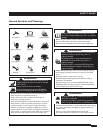
11
8. Move Choke Lever to RUN ( ) position a short distance
at a time over several seconds in warm weather or several
minutes in cold weather. Let engine run smoothly before
each change. Operate with choke in RUN position.
9. After engine has been running 1-2 minutes, close start
valve (turn fully horizontal) (see Figure 11).
NOTE: If the engine fails to start, refer to
TROUBLESHOOTING on page 22.
NOTE: If you hear air leaking, pull quick connect coupler(s)
back until it clicks to reset coupler valve.
The air compressor is fully automatic and is controlled by the
Pilot Valve.The compressor runs until pressure in the air
tanks reaches “cut-out” pressure, then engine slows to idle
speed.The compressor will resume full speed when pressure
in the air tanks falls below the “cut-in” pressure. See
GLOSSARY on page 24 for definitions.
NOTE: Always operate the air compressor in well-ventilated
areas free of gasoline or other flammable/combustible vapors.
If the compressor is being used to spray volatile chemicals
(such as paint), locate the compressor at least 20 feet
(6.1 meters) away from the spray area.
Stopping Your Air Compressor
1. Turn engine ON/OFF switch to OFF position
(see Figure 9).
2. Move Fuel Shutoff Valve lever to OFF position
(see Figure 8 earlier).
3. Pull the Safety Valve ring to release most of the tank’s
compressed air. Release valve ring.
4. Open Drain Valves to fully drain the air tanks.
NOTE: The compressor generates condensation water
(condensate) that accumulates in the air tank. Drain the
condensate every 4 hours or daily.
5. Close Drain Valves.
Transport
Be sure to transport the compressor in a safe manner and be
sure to the secure unit in a stable position. DO NOT move
unit while engine is running.
OPERATION
• DO NOT touch hot surfaces and avoid hot exhaust gases.
• Allow equipment to cool before touching.
• Keep at least 5 feet (152 cm) of clearance on all sides of air
compressor including overhead.
• Code of Federal Regulation (CFR) Title 36 Parks, Forests, and
Public Property require equipment powered by an internal
combustion engine to have a spark arrester, maintained in
effective working order, complying to USDA Forest service
standard 5100-1C or later revision. In the State of California a
spark arrester is required under section 4442 of the California
Public resources code. Other states may have similar laws.
Running engines produce heat.Temperature of
muffler and nearby areas can reach or exceed
150°F (65°C).
Severe burns can occur on contact.
Exhaust heat/gases can ignite combustibles,
structures or damage fuel tank causing a fire.
WARNING
Figure 11 - Start Valve
• Use the handles to lift or carry the unit.
• ALWAYS transport the unit with the engine shut off, spark plug
disconnected, Fuel Tank empty, and Fuel Shutoff Valve OFF.
• ALWAYS transport, operate, and store this unit on a level
surface to avoid tipping hazards and lubrication problems.
Unit is heavy.Take care when lifting or moving
unit.
Ensure proper footing and use caution when
rolling compressor so unit does not tip, cause loss
of balance, or spill fuel.
CAUTION
Start valve is shown in
CLOSED position
• DO NOT stop engine by moving choke lever to “Choke”
position.
Backfire, fire or engine damage could occur.
CAUTION


















